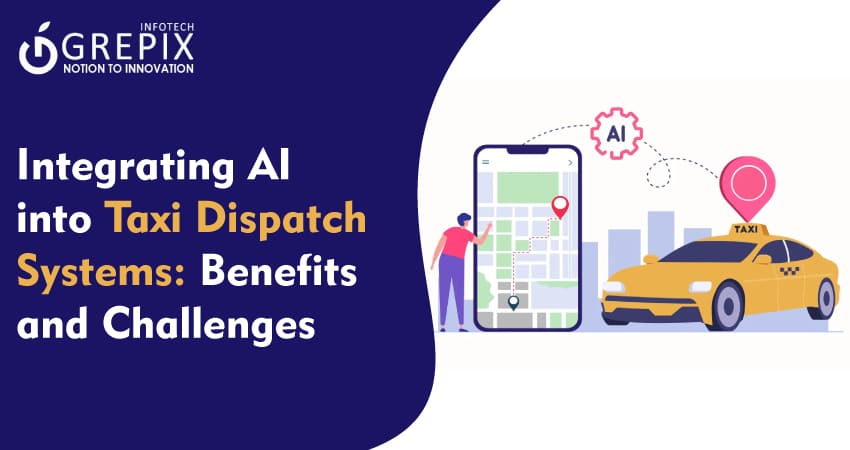Integrating AI into Taxi Dispatch Systems: Benefits and Challenges
In an era defined by rapid technological advancements, artificial intelligence (AI) is reshaping industries, including transportation. The taxi industry, often characterized by outdated manual systems and inefficiencies, is now undergoing a profound transformation with the integration of AI into dispatch systems. From optimizing routes to predicting demand, AI is revolutionizing how taxis operate, benefitting passengers and operators. However, these advancements are not without their challenges. This article explores the benefits and hurdles of integrating AI into taxi dispatch systems, offering a comprehensive view of this pivotal transition.
Artificial intelligence (AI) is transforming the taxi industry, modernizing outdated dispatch systems with advanced, data-driven solutions. AI-powered systems optimize routes, predict passenger demand, and enhance fleet efficiency, reducing wait times for passengers and operational costs for taxi operators. However, challenges such as high implementation costs, data privacy concerns, and workforce adaptation must be addressed to unlock AI's full potential. Successful case studies from companies like Uber, Grab, and DiDi demonstrate AI's capability to revolutionize urban mobility. With future advancements like autonomous vehicles and smart city integration, AI is poised to redefine transportation, creating smarter, more efficient systems for operators and passengers alike.
Understanding Taxi Dispatch Systems
What is a Taxi Dispatch System?
A taxi dispatch system is the backbone of a modern taxi service. It connects drivers to passengers, ensuring efficient trip assignment and coordination. Traditional dispatch systems rely heavily on human operators, who manually match ride requests with available drivers. While effective in their time, these systems often struggle to handle high demand or unexpected traffic patterns, resulting in delays and inefficiencies.
Traditional vs. AI-Powered Dispatch Systems
Traditional dispatch systems are linear and limited in scope, primarily operating on static schedules and predefined routes. On the other hand, AI-powered dispatch systems leverage advanced algorithms to analyze real-time data, predict demand, and allocate resources dynamically. This shift not only improves service efficiency but also sets the stage for a more responsive and adaptive taxi service.
The Role of AI in Modern Taxi Dispatch Systems
AI serves as the intelligence layer in modern dispatch systems, enabling smarter decision-making through data-driven insights. By analyzing vast amounts of real-time data, AI algorithms can:
- Predict passenger demand in specific areas
- Optimize fleet allocation to minimize idle time
- Adapt to changing traffic conditions in real-time
These capabilities allow taxi operators to provide faster and more reliable services, which are crucial in today’s fast-paced world.
Key Benefits of AI Integration in Taxi Dispatch
Optimized Route Planning
One of AI’s standout features is its ability to optimize routes. Advanced algorithms analyze live traffic data, historical patterns, and road conditions to recommend the fastest and most fuel-efficient paths. This benefits both drivers, who save on fuel costs, and passengers, who enjoy shorter wait and travel times.
Reduced Waiting Time for Passengers
Nobody likes waiting for a taxi, especially in unpredictable weather or during peak hours. AI dispatch systems predict demand surges and preemptively position vehicles in high-demand areas. This proactive approach significantly reduces passenger wait times, enhancing customer satisfaction.
Enhanced Fleet Utilization
Efficient fleet management is a cornerstone of profitable taxi operations. AI ensures that no vehicle sits idle for long periods by distributing trips evenly across the fleet. It can also analyze driver performance and suggest ways to improve operational efficiency, maximizing fleet utilization.
Cost Efficiency for Operators
By automating processes and reducing inefficiencies, AI-powered dispatch systems lower operational costs. Fuel savings, optimized routes, and reduced idle times contribute to a leaner operation. For small and large taxi operators, these cost benefits directly translate into increased profitability.
Challenges of Integrating AI into Taxi Dispatch Systems
While the benefits of AI integration are compelling, the journey comes with challenges.
Implementation Costs
AI solutions require significant upfront investments in hardware, software, and training. For small operators with limited budgets, these costs can be prohibitive. Additionally, ongoing maintenance and updates can strain financial resources.Data Privacy Concerns
AI systems rely heavily on data, including passenger locations, travel patterns, and payment details. Safeguarding this information is critical to prevent data breaches and maintain customer trust. Taxi operators must ensure compliance with data protection laws, which can complicate implementation.
Resistance to Change in the Workforce
For drivers and dispatch staff accustomed to traditional systems, transitioning to AI-powered solutions can be daunting. Resistance to change, coupled with the need for extensive training, may delay adoption and hinder the full potential of AI integration.
Also Read: "Comparative Analysis: BlaBlaCar vs. Uber"
Examples of Successful AI Implementation
Case Studies from Leading Taxi Companies
Several taxi companies have already embraced AI to redefine their dispatch systems, with impressive results. For instance, ride-hailing giants like Uber and Lyft use AI-powered algorithms to match drivers with passengers efficiently. These systems analyze real-time demand, driver availability, and traffic conditions to optimize operations seamlessly.
In cities like Singapore, Grab has implemented AI to improve route planning and predict peak demand, significantly reducing passenger wait times. Similarly, DiDi Chuxing in China leverages AI to offer dynamic pricing models, ensuring fair competitiveness while maximizing driver earnings. These examples highlight how AI can elevate traditional taxi services to modern, efficient systems.
AI-Powered Apps Revolutionizing Urban Transport
Beyond individual taxi companies, AI-powered apps have emerged as game-changers for urban mobility. Apps like Curb and Ola integrate AI for scheduling, fare calculation, and route optimization. These platforms not only improve service quality but also provide passengers with transparent and user-friendly interfaces, further enhancing customer satisfaction.
Overcoming Challenges in AI Integration
Strategic Solutions for Common Hurdles
To address implementation costs, taxi operators can consider phased rollouts of AI technology. Starting with essential features, such as real-time traffic monitoring, allows operators to test the system and adjust before a full-scale deployment. Governments and private investors can also play a role by offering financial incentives for companies adopting AI.
For data privacy concerns, robust encryption and compliance with international data protection standards like GDPR can mitigate risks. Implementing transparent policies about data usage builds customer trust and ensures legal adherence.
Importance of Continuous Updates and Training
AI systems are only as good as their training. Regular updates and continuous staff education ensure technology remains relevant and effective. Providing drivers with hands-on training sessions and technical support fosters smoother transitions and reduces resistance to change. By creating a culture of innovation, companies can encourage workforce buy-in and maximize the benefits of AI integration.
The Future of AI in Taxi Dispatch Systems
Integration with Autonomous Vehicles
The next frontier for AI in taxi dispatch lies in its integration with autonomous vehicles. Self-driving cars rely heavily on AI for navigation, obstacle detection, and decision-making. By combining these vehicles with AI-powered dispatch systems, operators can create an ecosystem where fleets run with minimal human intervention. This shift promises to redefine urban mobility, offering unmatched efficiency and cost savings.
Smart City Compatibility
As cities worldwide adopt smart technologies, taxi dispatch systems must evolve to remain relevant. AI-powered systems can integrate with smart city infrastructure, such as IoT sensors and real-time traffic management networks. This connectivity allows for more precise route optimization and dynamic resource allocation, creating a seamless urban transportation experience.Conclusion
In an era where efficiency, adaptability, and customer satisfaction define the success of industries, the integration of AI into taxi dispatch systems is not just an innovation but a necessity. Grepix Infotech, a leading taxi app development company, recognizes this transformative potential and is committed to helping businesses navigate this technological revolution.
AI-powered dispatch systems offer unparalleled benefits, from optimizing routes and reducing passenger wait times to enhancing fleet utilization and cutting operational costs. Yet, these advancements come with challenges, including implementation costs, data privacy concerns, and workforce resistance. By addressing these hurdles through strategic planning, continuous training, and robust security measures, the taxi industry can fully embrace the opportunities AI presents.
As the future unfolds, AI's role in taxi dispatch systems will extend beyond operational efficiency to redefine urban transportation. With developments such as autonomous vehicles and smart city integrations on the horizon, the possibilities are endless. At Grepix Infotech, we are at the forefront of this evolution, empowering taxi operators with cutting-edge solutions to create a smarter, more efficient, and customer-centric transportation ecosystem. Together, we can shape the future of mobility.
Looking out to start your own venture like Uber? Try out our HireMe Taxi Uber Clone, the easiest way to kick-start your taxi business.







